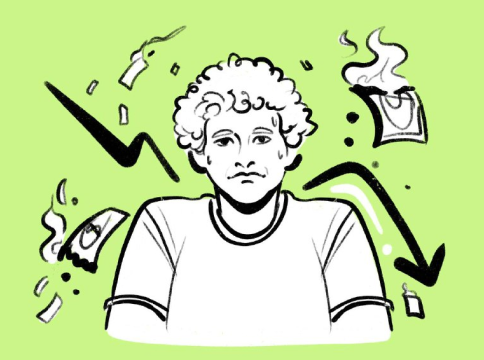How to burn billions of dollars in one night: the FTX collapse
The premise of this problem is very simple – you need to get rid of several billion dollars.
“What’s so difficult about that,” you might ask, “if we had billions of dollars, we’d take a gas burner, douse all the bills in gasoline, and burn them. Although, wait. Only a fool would get rid of them if they actually had billions of dollars!”
This is a tricky problem with a catch. Could a modest life solution help answer the main question of the problem: why earn billions first and then devise a plan to liquidate them? Perhaps a calculated technical solution can shed light on the main question?
Let’s read both solutions and choose one. The only correct one.
The life solution to this problem states: in order to get rid of something, you must first obtain it.
Kurt Degerman, a Swede, spent his entire life collecting empty bottles and living a poor vagrant’s existence, but he became famous for leaving behind a million-dollar fortune. The reason is a secret and wildly successful stint in the stock market.
And yes, Kurt Degerman is a real person, not a character from glowing advertising campaigns about the attractiveness of exchanges and the benefits of investments. Degerman became one of the most famous vagrants in the world and one of the richest, albeit posthumously.
As a child, the future millionaire from the slums was a gifted boy whose abilities were noted by teachers, considering him the best student in the class. Many were sure that Degerman would inevitably become a successful person, but a tragic accident intervened in Kurt’s life, forcing him to leave school. He distanced himself from peers and teachers, later becoming a street vagrant, sinking to the bottom rung of the social ladder.
Kurt Degerman spent most of his life – about 40 years – on the streets of the Swedish town of Skellefteå, earning a living by collecting empty bottles and cans from beer. This earned him the nickname “Kurt – Tin Can.” Outwardly, he was no different from other Swedish vagrants, very withdrawn, uncommunicative, and reclusive. He wore whatever he found in trash bins, mostly surviving on scraps or cheap fast food.
Yet Degerman was not “just another vagrant”; unlike many others, Kurt never spent money on alcohol or drugs. Neither his long-lost relatives nor his few street friends could imagine that in his spare time Degerman played on the stock market and invested money from collecting cans and glass bottles in securities and gold. It was from the proceeds of selling discarded bottles that he bought his first shares.
Degerman had an excellent grasp of finances – his capital grew almost constantly. He had a keen sense of when to buy stocks and when to sell. But how could such an antisocial character even learn about the existence of stock exchanges and speculation?
He saw newspaper headlines passing by newsstands. However, for Kurt Degerman, like any other vagrant, buying and studying the press every day was difficult. After going around the city in search of bottles and cans, Kurt spent all his free time in free municipal libraries – reading economic and analytical newspapers Swedish Business Daily and Dagens Industri. It was from these papers that he gleaned stock market news, allowing him to stay informed of all exchange processes and successfully invest, relying not only on his intuition.
As a result of many years of trading on the stock exchange and a maximally ascetic life, Degerman amassed a huge fortune, which no one ever suspected.
At the age of 60, due to natural causes, Kurt Degerman left this world and instantly became famous: after his death, about $1.4 million was discovered in his account, namely 8 million kronor ($1.1 million) in stocks and other securities in a Swiss bank, as well as 124 gold bars in a bank vault totaling 2.6 million kronor ($300,000). In another bank in Skellefteå, Kurt kept $6,500, and he also had a small and modest house where he kept $450 in cash.
The specific composition of the Swedish vagrant’s investment portfolio remained a secret – it is known only that he invested in shares of “the best companies in Sweden.”
Interestingly, as a millionaire, Degerman did nothing to improve his own life. He never flaunted his activities or sought recognition and fame. He simply enjoyed the process.
From this solution, two conclusions can be drawn:
In order to obtain something, do what you respect yourself for and stop doing what you do not respect yourself for.
Then no one will ever destroy what you have.

The author of the technical solution is a person who in November 2022 broke the cryptocurrency market, making all investors cry bloody tears and gulp Valium in spasms.
This person is called Sam Bankman-Fried. By the age of 30, he managed to amass over $15 billion in personal wealth: first succeeding in traditional trading and then shifting to cryptocurrencies.
That’s why the cryptocurrency exchange FTX he founded in 2019 became a leader in trading various derivatives – contracts between the asset seller and buyer.
Sam started living large – giving numerous interviews, willingly allocating huge sums for advertising his exchange, involving celebrities, and even naming entire stadiums after FTX. Everything was going perfectly until November 2022.
On November 2, the news portal CoinDesk published an article that raised serious doubts about the stability of the FTX exchange. Referring to a secret document they obtained and their investigation, journalists reported that about 40% of the assets of Sam Bankman-Fried’s personal hedge fund, Alameda Research, consisted of FTT tokens issued by the FTX exchange.
This was a serious issue because such a large volume of FTT tokens (over $5.8 billion) was highly illiquid. In case of significant cash needs at Alameda Research, attempting to sell such a large package of FTT tokens would sharply reduce their prices and likely lead to the fund’s bankruptcy.
After the revealing article, FTT token prices started to fall. By November 6, they had dropped nearly 7%. But this was just the beginning. On the same day, Changpeng Zhao announced on Twitter that Binance planned to divest its FTT holdings worth around $500 million. After this public statement, the situation took a threatening turn: FTT fell another 8%, which carried fatal consequences.
What did Bankman-Fried do? He rushed to declare that the negative news about the FTX exchange was “false rumors intentionally spread by the main competitor. And we know who he is,” and that “FTX is fine. Assets are fine.” But the human panic around the rapidly rising exchange was already unstoppable.
Returning to some time ago to study the scheme more closely: at the beginning of the technical solution, we mentioned that bankruptcy threatened a completely different company – Alameda Research. So what does the FTX exchange have to do with it?
The fact is, both of these companies belonged to the same person – the hero of this article. Sam Bankman-Fried virtually owned the pocket hedge fund Alameda Research entirely and more than half of the cryptocurrency exchange FTX. All the details of the interaction between these two companies were never disclosed, but after the secret document was exposed, new facts emerged. Lucas Nuzzi, head of Coin Metrics’ blockchain research department, determined that FTX provided Alameda emergency funding of $4 billion in FTT tokens, tokens issued by the exchange owned half by the future bankrupt company’s owner. Excellent plan! Only thanks to such a plan, if Alameda Research did collapse, the return on the exchange-issued FTX loans, tokens, would have been in doubt.
After the disclosure of such facts, FTX clients experienced a real panic: as of November 8, withdrawals from the cryptocurrency exchange reached $6 billion, and the FTT token had fallen by 80% since the beginning of the month. At some point, the exchange imposed withdrawal restrictions, then completely stopped this process. It was at this moment that even the last doubters understood that FTX had serious problems fulfilling its obligations.
It would have been more logical to admit defeat, return all clients’ money, and think about how to move forward. Traditional exchanges rarely have problems returning client funds: usually, exchanges simply act as intermediaries in the asset ownership chain and charge a small commission fee for this. Even if all clients suddenly wanted to withdraw their funds, this would not lead to the exchange’s bankruptcy, as all obligations to clients are backed by specific assets of these clients in the exchange’s accounts.
So why couldn’t FTX fulfill its obligations? The answer is simple: the exchange did not hesitate to use clients’ assets for various questionable purposes, including “saving” the Alameda fund owned by the same owner.
In order not to completely lose face, Sam Bankman-Fried tried to sell part of the company to get some external financing, tried to negotiate with former partner Changpeng Zhao about Binance acquiring the FTX exchange.
Apparently, the size of the discovered hole in FTX’s balance sheet was too large, and Sam Bankman-Fried overnight turned from the second richest person in the crypto world into an ordinary unemployed person. He practically instantly lost most of his accumulated wealth: before the fraud was discovered, Bloomberg estimated his wealth at $15.6 billion; after the collapse of FTX, Bankman-Fried’s fortune decreased by almost 95%.
From this story, two conclusions can be drawn:
If you don’t want to lose several billion dollars, don’t use a token you created as collateral, and never use borrowed funds if you manage a crypto business.
And if you do want to lose billions after all… Well, that’s enough technology for today.

Dark matter whispers secrets only geniuses can hear.
Thank you!




